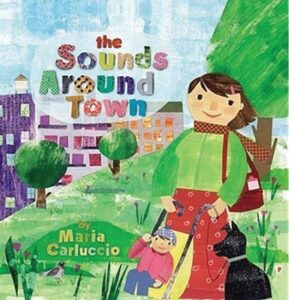Awareness of differences in sounds, Expressive language
Toddlers participate in a book sharing about sounds made by people, animals, and objects.

The Sounds Around Town by Maria Carluccio



[Invite 3–4 toddlers to read a book about sounds we hear. Show the book cover.]
 What do we see on the cover of our book?
What do we see on the cover of our book?
[Point to the baby and mother when each is mentioned by toddlers. Explain that the baby is in a stroller and seems to be ready to go somewhere.]
Our book tells about the different sounds heard by the baby we see on the cover of our book. We get to follow the baby all day.
We hear sounds wherever we are. We hear sounds in our room, on our play yard, and at our home.
Let’s find out where the baby goes and what sounds the baby hears.
[Use the following strategies to share the book:
The baby in our book heard many different sounds, all on one day! We made the sounds the baby heard. What sound was the most fun to make?
Awareness of differences in sounds is a building block of later reading skills. The current activity promotes the beginnings of sound awareness by helping toddlers recognize, and also make, different sounds. It is beneficial for toddlers to explore sounds made by animals and objects as well as by people. Look for opportunities to help toddlers imagine they are the baby hearing the sounds. Example: “Let’s pretend we are the baby in the bathtub. We hear ‘pop, pop.’” Also, look for facial expressions or other signs that a toddler may not be familiar with an animal or item featured in the book. Offer explanations as appropriate.
Extra support
Enrichment
Awareness of differences in sounds, Expressive language
Toddlers identify sounds heard while sitting quietly in their room and talking about their sources.



Invite 4–6 toddlers to join you in listening for sounds in our room. Offer the activity in a quieter area of your room.
Open the session by explaining that we hear sounds all the time. Let’s find out what kinds of sounds we can hear in our room. Encourage toddlers to sit quietly and listen for sounds. When we hear a sound, we can use our hands to point to our ears. Then we can take turns telling about the sound we hear. Explain that we may hear sounds that happen outside our room while sitting in our room.
Support 2–4 different “time to listen” periods, each followed by discussion of sounds heard. This enables about 2–3 different sounds to be discussed at one time. Discussing all sounds at one time can present a recall challenge for toddlers. Invite one toddler at a time to talk about the sound he/she heard. Encourage the toddler to describe what he/she heard and maybe try to make the sound. Encourage other toddlers who heard the sound to talk about what they heard.
Provide opportunity for all toddlers to talk about a sound they heard. Conclude the session by asking toddlers to help you tell again all the sounds we heard.
Toddlers’ sound identifications are likely to focus on the source of the sound, such as hearing a door close or peers talking or playing. Gently encourage a toddler to tell some specifics of a sound. Example: If a toddler says he/she heard “kids playing,” ask what kinds of sounds children were making while playing. Offer some suggestions, if appropriate. Example: “Did you hear kids talking or laughing?”
Extra support
 In the opening segment, remind toddlers that we made and talked about sounds heard by a baby in The Sounds Around Town book (Option 1). Show the book cover.
In the opening segment, remind toddlers that we made and talked about sounds heard by a baby in The Sounds Around Town book (Option 1). Show the book cover.Enrichment
Materials Needed: several familiar wordless books, such as A Ball for Daisy and Good Dog, Carl
Provide several wordless books shared recently with toddlers. Invite several toddlers to look at pictures in the book, and think and talk about the sounds that a character in the book might hear. Examples: What would Daisy hear when the ball lost its air? What would Carl hear when the baby was swimming in the fish tank?
Materials Needed: see activity description
Invite preschool-age children to join the Option 2 activity and participate in the Interest Area activity. School-age children may enjoy making a written or illustrated list of sounds heard in Option 2.